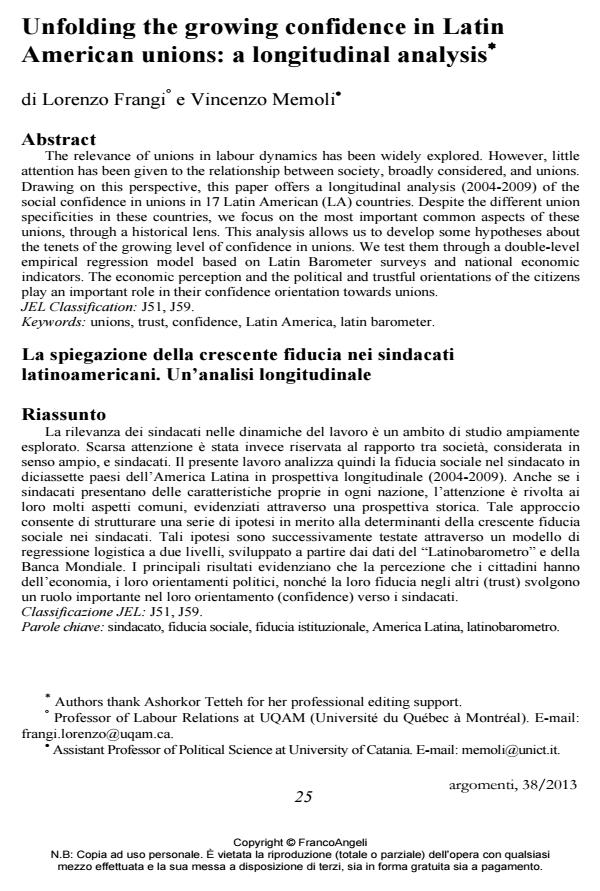Unfolding the growing confidence in Latin American unions: a longitudinal analysis
Journal title ARGOMENTI
Author/s Lorenzo Frangi, Vincenzo Memoli
Publishing Year 2013 Issue 2013/38
Language Italian Pages 22 P. 25-46 File size 670 KB
DOI 10.3280/ARG2013-038002
DOI is like a bar code for intellectual property: to have more infomation
click here
Below, you can see the article first page
If you want to buy this article in PDF format, you can do it, following the instructions to buy download credits

FrancoAngeli is member of Publishers International Linking Association, Inc (PILA), a not-for-profit association which run the CrossRef service enabling links to and from online scholarly content.
The relevance of unions in labour dynamics has been widely explored. However, little attention has been given to the relationship between society, broadly considered, and unions. Drawing on this perspective, this paper offers a longitudinal analysis (2004-2009) of the social confidence in unions in 17 Latin American (LA) countries. Despite the different union specificities in these countries, we focus on the most important common aspects of these unions, through a historical lens. This analysis allows us to develop some hypotheses about the tenets of the growing level of confidence in unions. We test them through a double-level empirical regression model based on Latin Barometer surveys and national economic indicators. The economic perception and the political and trustful orientations of the citizens play an important role in their confidence orientation towards unions.
La rilevanza dei sindacati nelle dinamiche del lavoro è un ambito di studio ampiamente esplorato. Scarsa attenzione è stata invece riservata al rapporto tra società, considerata in senso ampio, e sindacati. Il presente lavoro analizza quindi la fiducia sociale nel sindacato in diciassette paesi dell’America Latina in prospettiva longitudinale (2004-2009). Anche se i sindacati presentano delle caratteristiche proprie in ogni nazione, l’attenzione è rivolta ai loro molti aspetti comuni, evidenziati attraverso una prospettiva storica. Tale approccio consente di strutturare una serie di ipotesi in merito alla determinanti della crescente fiducia sociale nei sindacati. Tali ipotesi sono successivamente testate attraverso un modello di regressione logistica a due livelli, sviluppato a partire dai dati del "Latinobarometro" e della Banca Mondiale. I principali risultati evidenziano che la percezione che i cittadini hanno dell’economia, i loro orientamenti politici, nonché la loro fiducia negli altri (trust) svolgono un ruolo importante nel loro orientamento (confidence) verso i sindacati.
Keywords: Unions, trust, confidence, Latin America, latin barometer
Jel codes: J51, J59.
- Social Confidence in Unions: A U.S.‐Canada Comparison Lorenzo Frangi, Marc‐Antonin Hennebert, Vincenzo Memoli, in Canadian Review of Sociology/Revue canadienne de sociologie /2014 pp.170
DOI: 10.1111/cars.12041 - Expressing Confidence in Unions in Quebec and the Other Canadian Provinces: Similarities and Contrasts in Findings Lorenzo Frangi, Marc-Antonin Hennebert, in Relations industrielles /2015 pp.131
DOI: 10.7202/1029283ar
Lorenzo Frangi, Vincenzo Memoli, Unfolding the growing confidence in Latin American unions: a longitudinal analysis in "ARGOMENTI" 38/2013, pp 25-46, DOI: 10.3280/ARG2013-038002